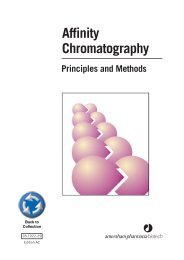Mutation of YCS4, a Budding Yeast Condensin Subunit - Molecular ...
Mutation of YCS4, a Budding Yeast Condensin Subunit - Molecular ...
Mutation of YCS4, a Budding Yeast Condensin Subunit - Molecular ...
Create successful ePaper yourself
Turn your PDF publications into a flip-book with our unique Google optimized e-Paper software.
N. Bhalla et al.Figure 5. <strong>YCS4</strong> is required for mitoticcondensation, stability, and segregation<strong>of</strong> rDNA. (A) The rDNA is decondensedin ycs4-1 mutants. Fluorescentin situ hybridization with probesagainst the rDNA was performed onwild type (NBY8) and ycs4-1 (NBY319)arrested in metaphase at the nonpermissivetemperature (37 o C). Comparedwith the loops present in wild-typerDNA, the rDNA in ycs4-1 cells appearscollapsed into an amorphousmass at the periphery <strong>of</strong> the DNAstaining. Bar, 10 m. (B) Results <strong>of</strong> insitu hybridization were quantified. In69% <strong>of</strong> ycs4-1 cells arrested in metaphase,the rDNA appears decondensed,as compared with 4.5% <strong>of</strong>wild-type cells. (C) Segregation <strong>of</strong> thenucleolus is defective in ycs4-1. Indirectimmun<strong>of</strong>luorescence for the nucleolarmarker Nop1p was performed onwild-type (NBY8) and ycs4-1 (NBY319)cells in anaphase (120 min after releasefrom G1). The percentage <strong>of</strong> cells withsegregated or unsegregated nucleoliwas scored and graphed. Only 10% <strong>of</strong>wild-type cells in anaphase have not segregated their nucleolus; 45% <strong>of</strong> ycs4-1 cells with elongated spindles still contain the nucleolus in themother bud (as identified by the persistence <strong>of</strong> the -factor induced shmoo). (D) Loss <strong>of</strong> nucleolar structure may inhibit its segregation. Awild-type (NBY8) cell is shown on the left and a ycs4-1 mutant (NBY319) cell on the right. DNA staining (DAPI) is shown in the top pair <strong>of</strong>panels, anti-tubulin antibody staining in the middle, and anti-Nop1p antibody staining on the bottom. The wild-type cell has segregated itscrescent-shaped nucleolus into each cell body. The nucleolus in the ycs4-1 cell has lost its structure and is found in the mother cell body; theamorphous Nop1p-containing mass is typical <strong>of</strong> the 45% <strong>of</strong> cells with an unsegregated nucleolus. Bar, 10 m.nucleolar marker Nop1p to both mother and bud, and only10% <strong>of</strong> cells contained Nop1p only in the mother (identifiedby the pheromone-induced shmoo morphology) (Figure5C). In ycs4-1 cells undergoing anaphase, 45% <strong>of</strong> the cellsexhibited Nop1p only in the mother (Figure 5C). Furthermore,these cells had a perturbed nucleolar structure: the nucleolus isnot bar- or crescent-shaped as in wild type, but diffuse andamorphous, consistent with the in situ hybridization results(Figure 5D). The remaining 55% <strong>of</strong> the cells had segregatedtheir nucleoli and exhibited normal Nop1p staining.ycs4-1 Is Defective in Silencing <strong>of</strong> Silent MatingType LocusInitial attempts to arrest ycs4-1 MATa cells in media containing-factor at the permissive temperature failed. Whenthese cells were plated on YPD plates containing -factor,they did not respond to the pheromone and continued togrow (Figure 6A). ycs4-1’s -factor resistance was overcomewhen the silent mating locus HML was deleted (Figure 6A),suggesting that the mutant was defective in silencing at themating type loci. Silencing defects were not observed at thetelomere at the permissive temperature (Figure 6B), andsilencing at the rDNA could not be assayed because theintegration <strong>of</strong> the reporter construct (Smith and Boeke, 1997)at the rDNA is synthetically lethal with the ycs4-1 mutation(our unpublished results).DISCUSSIONWe have shown that <strong>YCS4</strong>, a regulatory subunit <strong>of</strong> thecondensin complex, is required for accurate sister chromatidTable 2. Mitotic frequency <strong>of</strong> marker lossRecombination frequencies were determined as described in MATERIALS AND METHODS. Values are reported as the means andstandard deviations and were determined on at least three independent trials for each genotype.RDNURA3leu2URA3leu2GenotypeRecombination frequency10 3Fold increaseRecombination frequency10 3Fold increasewildtype 0.4 0.3 1 0.3 0.3 1top1 15 3 38 5 3 17top2-4 1 1 3 0.8 0.2 3top1top2-4 33 5 83 8 4 27ycs4-1 25 4 63 0.5 0.5 2640<strong>Molecular</strong> Biology <strong>of</strong> the Cell
















